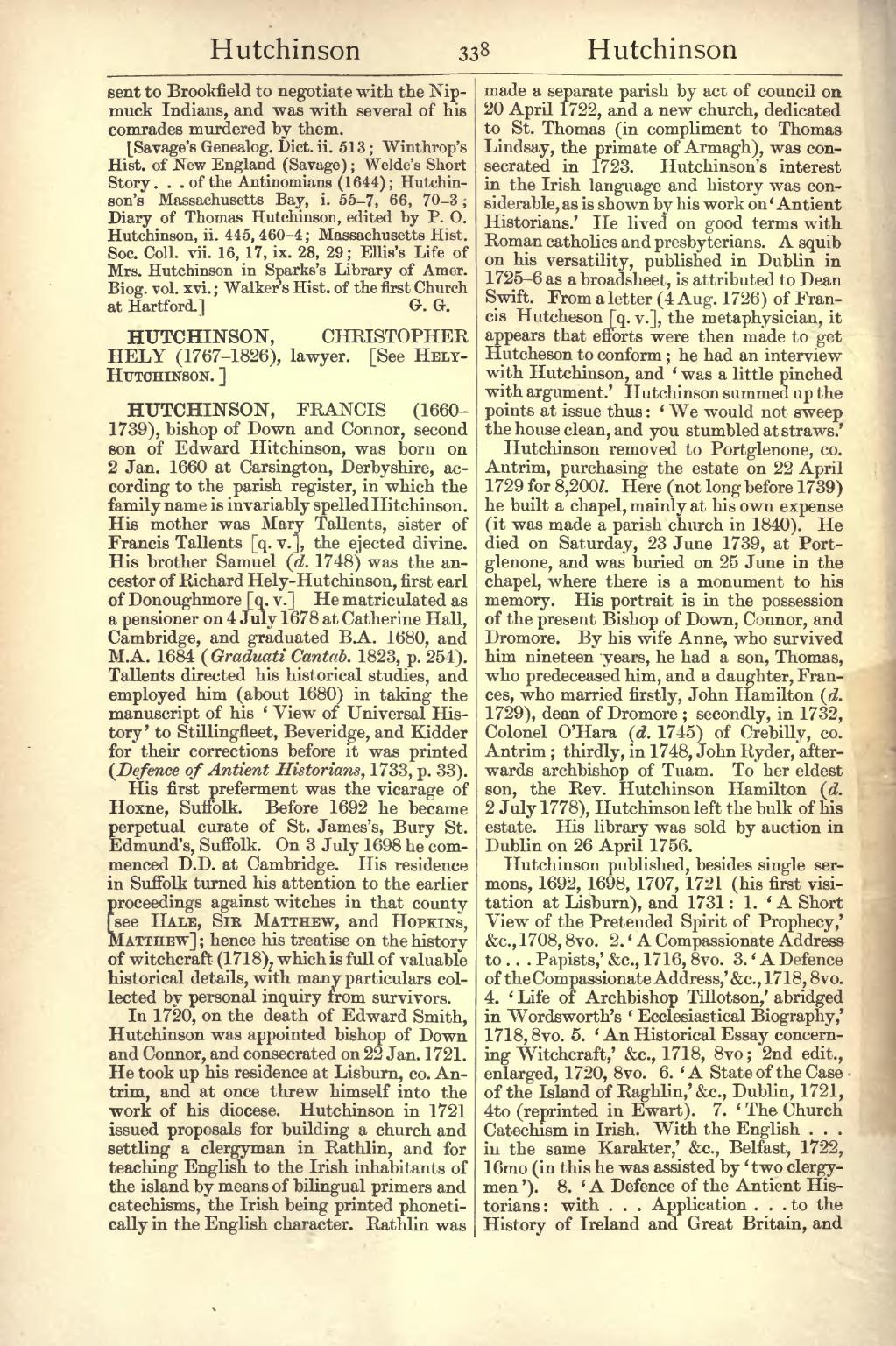sent to Brookfield to negotiate with the Nipmuck Indians, and was with several of his comrades murdered by them.
[Savage's Genealog. Dict. ii. 513; Winthrop's Hist. of New England (Savage); Welde's Short Story…of the Antinomians (1644); Hutchinson's Massachusetts Bay, i. 55-7, 66, 70-3; Diary of Thomas Hutchinson, edited by P.O.Hutchinson, ii. _445,460-4; Massachusetts Hist. Soc. Coll. vii. 16, 17, ix. 28, 29; Ellis's Life of Mrs. Hutchinson in Sparks's Library of Amer. Biog. vol. xvi.; Walker's Hist. of the first Church at Hartford.]
HUTCHINSON, CHRISTOPHER HELY (1767–1826), lawyer. [See Hely-Hutchinson.]
HUTCHINSON, FRANCIS (1660–1739), bishop of Down and Connor, second son of Edward Hitchinson, was born on 2 Jan. 1660 at Carsington, Derbyshire, according to the parish register, in which the family name is invariably spelled Hitchinson. His mother was Mary Tallents, sister of Francis Tallents [q.v.], the ejected divine. His brother Samuel (d. 1748) was the ancestor of Richard Hely-Hutchinson, first earl of Donoughmore [q. v.]| He matriculated as a pensioner on 4 July 1678 at Catherine Hall, Cambridge, and graduated B.A. 1680, and M.A. 1684 (Graduati Cantab. 1823, p. 254). Tallents directed his historical studies, and employed him (about 1680) in taking the manuscript of his 'View of Universal History' to Stillingfleet, Beveridge, and Kidder for their corrections before it was printed (Defence of Antient Historians, 1733, p.33).
His first preferment was the vicarage of Hoxne, Suffolk. Before 1692 he became perpetual curate of St. James's, Bury St. Edmund's, Suffolk. On 3 July 1698 he commenced D.D. at Cambridge. His residence in Suffolk turned his attention to the earlier proceedings against witches in that county [see Hale, Sir Matthew, and Hopkins, Matthew]; hence his treatise on the history of witchcraft (1718), which is full of valuable historical details, with many particulars collected by personal inquiry from survivors.
In 1720, on the death of Edward Smith, Hutchinson was appointed bishop of Down and Connor, and consecrated on 22 Jan. 1721. He took up his residence at Lisburn, co. Antrim, and at once threw himself into the work of his diocese. Hutchinson in 1721 issued proposals for building a church and settling a clergyman in Rathlin, and for teaching English to the Irish inhabitants of the island by means of bilingual primers and catechisms, the Irish being printed phonetically in the English character. Rathlin was made a separate parish by act of council on 20 April 1722, and a new church, dedicated to St. Thomas (in compliment to Thomas Lindsay, the primate of Armagh), was consecrated in 1723. Hutchinson's interest in the Irish language and history was considerable, as is shown by his work on' Antient Historians.' He lived on good terms with Roman catholics and presbyterians. A squib on his versatility, published in Dublin in 1725-6 as a broadsheet, is attributed to Dean Swift. From a letter (4 Aug. 1726) of Francis Hutcheson [q. v.], the metaphysician, it appears that efforts were then made to get Hutcheson to conform; he had an interview with Hutchinson, and ' was a little pinched with argument.' Hutchinson summed up the points at issue thus: 'We would not sweep the house clean, and you stumbled at straws'
Hutchinson removed to Portglenone, co. Antrim, purchasing the estate on 22 April 1729 for 8,200l. Here (not long before 1739) he built a chapel, mainly at his own expense (it was made a parish church in 1840). He died on Saturday, 23 June 1739, at Portglenone, and was buried on 25 June in the chapel, where there is a monument to his memory. His portrait is in the possession of the present Bishop of Down, Connor, and Dromore. By his wife Anne, who survived him nineteen years, he had a son, Thomas, who predeceased him, and a daughter, Frances, who married firstly, John Hamilton (d.1729), dean of Dromore; secondly, in 1732, Colonel O'Hara (d. 1745) of Crebilly, co. Antrim; thirdly, in 1748, John Ryder, afterwards archbishop of Tuam. To her eldest son, the Rev. Hutchinson Hamilton (d.2 July 1778), Hutchinson left the bulk of his estate. His library was sold by auction in Dublin on 26 April 1756.
Hutchinson published, besides single sermons, 1692, 1698, 1707, 1721 (his first visitation at Lisburn), and 1731:
- 'A Short View of the Pretended Spirit of Prophecy,' &c., 1708, 8vo.
- 'A Compassionate Address to … Papists,' &c., 1716, 8vo.
- A Defence of the Compassionate Address,' &c., 1718, 8vo.
- 'Life of Archbishop Tillotson,' abridged in Wordsworth's 'Ecclesiastical Biography,' 1718, 8vo.
- 'An Historical Essay concerning Witchcraft,' &c., 1718, 8vo; 2nd edit., enlarged, 1720, 8vo.
- 'A State of the Case of the Island of Raghlin,' &c., Dublin, 1721, 4to (reprinted in Ewart).
- 'The Church Catechism in Irish. With the English … in the same Karakter,' &c., Belfast, 1722, 16mo (in this he was assisted by ' two clergymen ').
- 'A Defence of the Antient Historians: with … Application … to the History of Ireland and Great Britain, and
